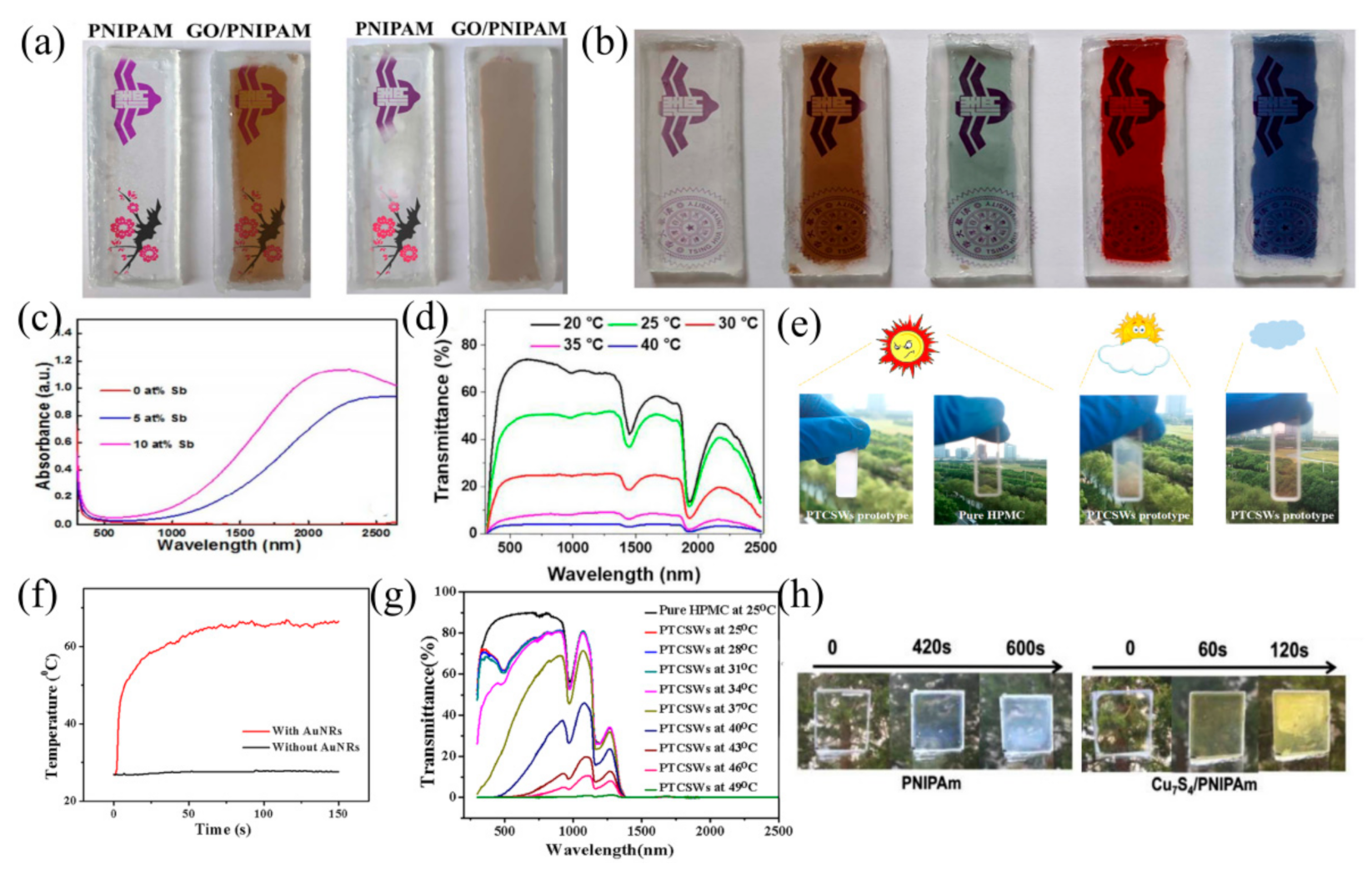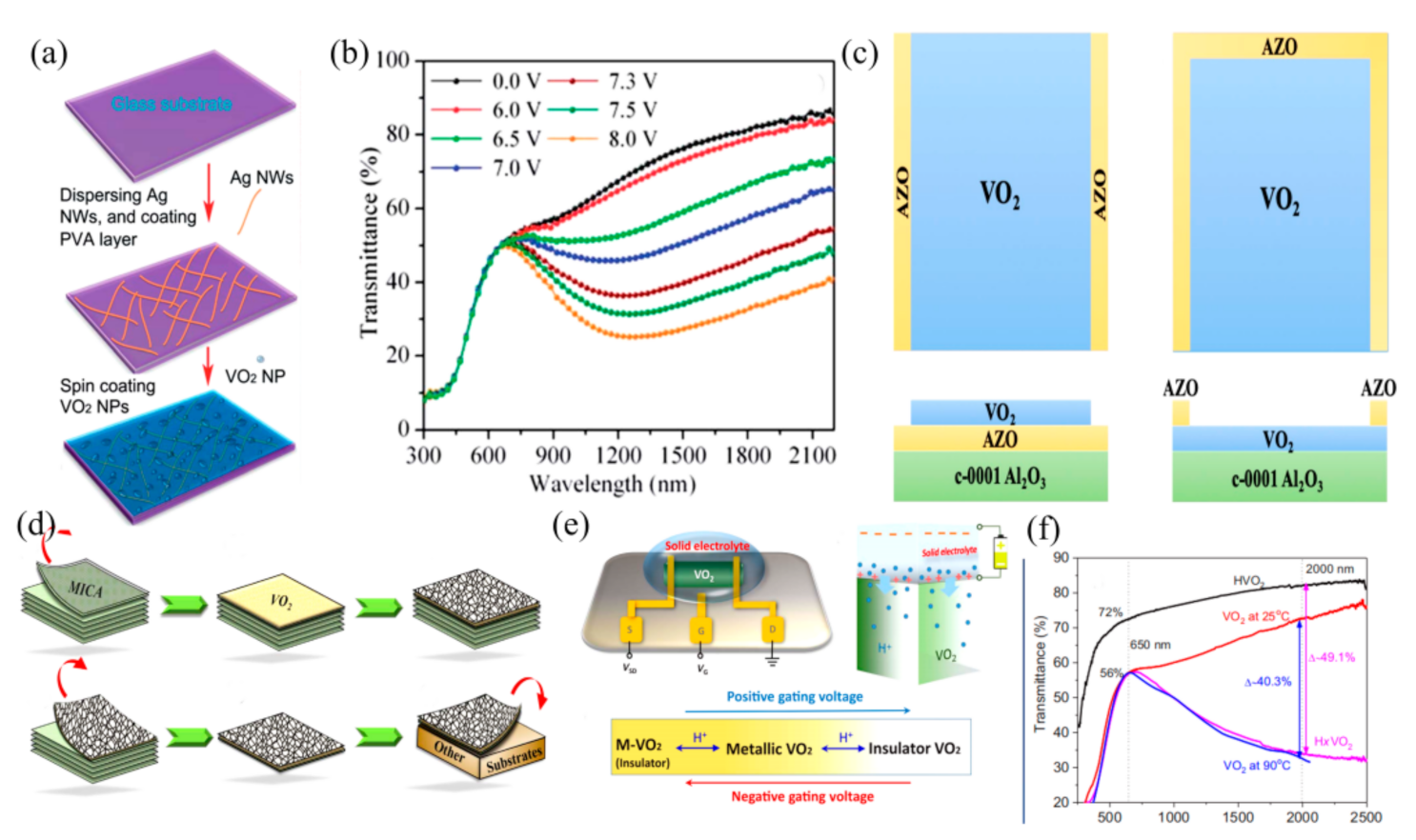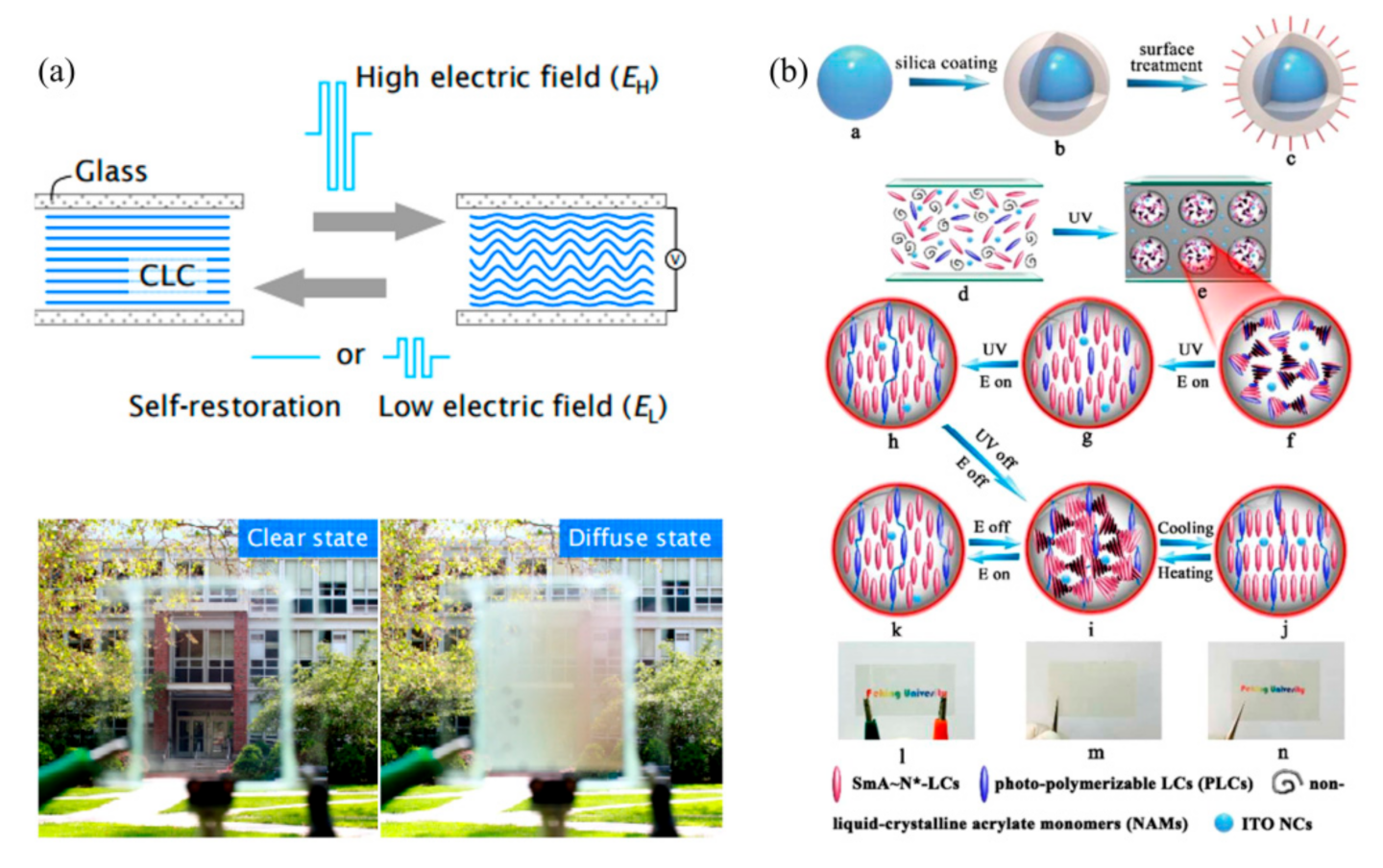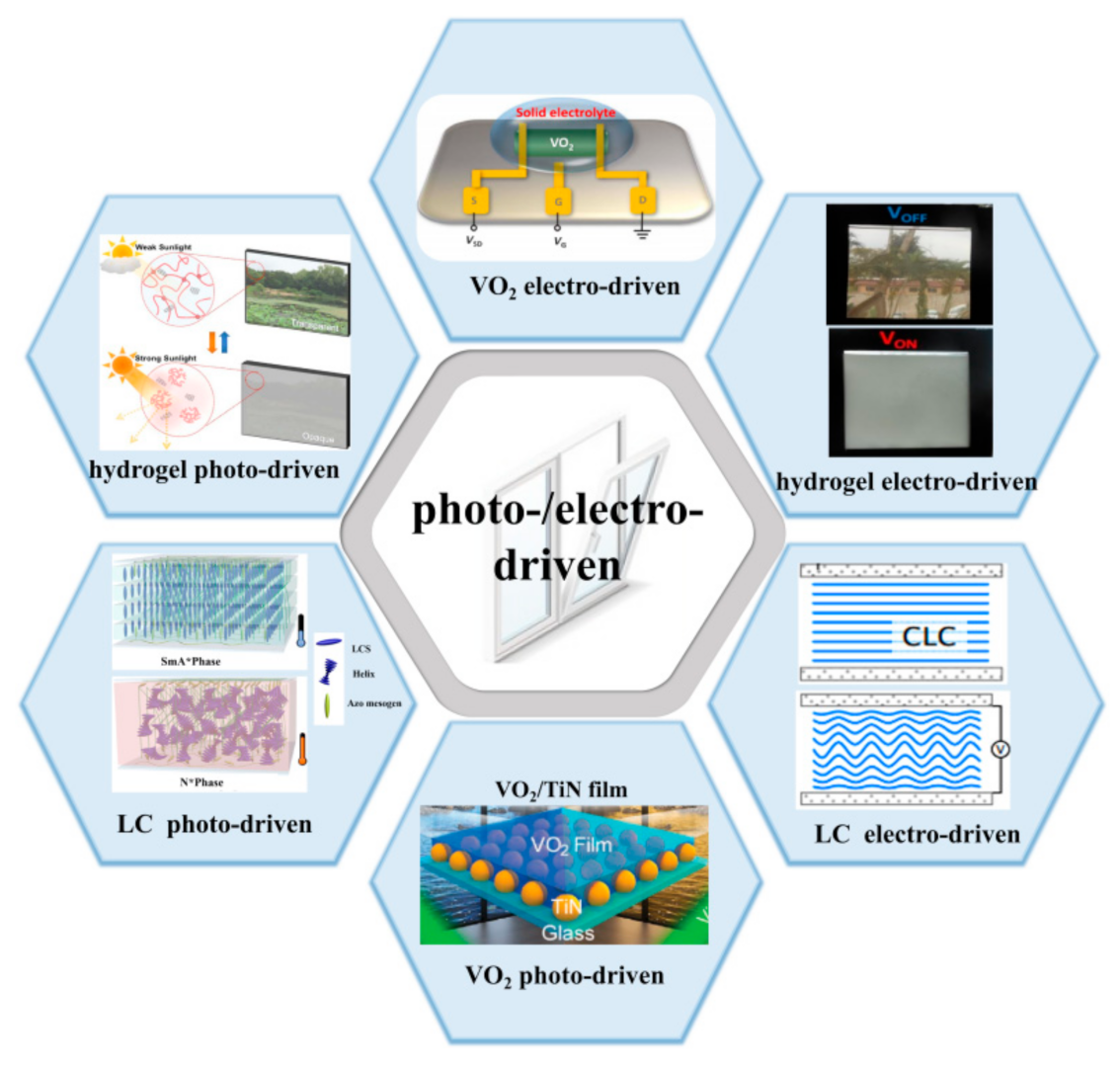Research Progress of Photo-/Electro-Driven Thermochromic Smart Windows
Abstract
:1. Introduction
2. Photo-Driven Thermochromic Smart Windows
2.1. VO2-Based Smart Windows
2.2. Hydrogel Smart Windows

2.3. Liquid Crystal Smart Windows
2.4. Chapter Summary
3. Electro-Driven Thermochromic Smart Windows
3.1. VO2-Based Smart Windows

3.2. Hydrogel Smart Windows
3.3. Liquid Crystal Smart Windows

3.4. Chapter Summary
4. Conclusions
Author Contributions
Funding
Institutional Review Board Statement
Informed Consent Statement
Data Availability Statement
Conflicts of Interest
References
- Pérez-Lombard, L.; Ortiz, J.; Pout, C. A review on buildings energy consumption information. Energy Build. 2008, 40, 394–398. [Google Scholar] [CrossRef]
- Svensson, J.; Granqvist, C.G. Electrochromic coatings for smart windows: Crystalline and amorphous WO3 films. Thin Solid Films 1985, 126, 31–36. [Google Scholar] [CrossRef]
- Ji, H.; Liu, D.; Cheng, H.; Zhang, C. Inkjet printing of vanadium dioxide nanoparticles for smart windows. J. Mater. Chem. C. 2018, 6, 2424–2429. [Google Scholar] [CrossRef]
- Cui, Y.; Ke, Y.; Liu, C.; Chen, Z.; Wang, N.; Zhang, L.; Zhou, Y.; Wang, S.; Gao, Y.; Long, Y. Thermochromic VO2 for energy-efficient smart windows. Joule 2018, 6, 1707–1746. [Google Scholar] [CrossRef] [Green Version]
- Ji, H.; Liu, D.; Cheng, H.; Tao, Y. Large area infrared thermochromic VO2 nanoparticle films prepared by inkjet printing technology. Sol. Energy Mater. Sol. Cells 2019, 194, 235–243. [Google Scholar] [CrossRef]
- Kim, J.; Paik, T. Recent advances in fabrication of flexible, thermochromic vanadium dioxide films for smart windows. Nanomaterials 2021, 11, 23674. [Google Scholar] [CrossRef] [PubMed]
- Ji, H.; Liu, D.; Zhang, C.; Yang, L.; Cheng, H.; Zheng, W. Snowflake-Like monoclinic VO2 powders: Hydrothermal synthesis, characterization and in situ monitoring phase-transition behavior. Sci. Adv. Mater. 2017, 9, 861–867. [Google Scholar] [CrossRef]
- Ji, H.; Liu, D.; Zhang, C.; Yang, L. Vanadium dioxide nanopowders with tunable emissivity for adaptive infrared camouflage in both thermal atmospheric windows. Sol. Energy Mater. Sol. Cells 2018, 175, 96–101. [Google Scholar] [CrossRef]
- Ji, H.; Liu, D.; Cheng, H.; Zhang, C. VO2/ZnS core-shell nanoparticle for the adaptive infrared camouflage application with modified color and enhanced oxidation resistance. Sol. Energy Mater. Sol. Cells 2018, 176, 1–8. [Google Scholar] [CrossRef]
- Liu, D.; Ji, H.; Peng, R.; Cheng, H.; Zhang, C. Infrared chameleon-like behavior from VO2(M) thin films prepared by transformation of metastable VO2(B) for adaptive camouflage in both thermal atmospheric windows. Sol. Energy Mater. Sol. Cells 2018, 185, 210–217. [Google Scholar] [CrossRef]
- Ji, H.; Liu, D.; Cheng, H.; Zhang, C.; Yang, L.; Ren, D. Infrared thermochromic properties of monoclinic VO2 nanopowders using a malic acid-assisted hydrothermal method for adaptive camouflage. RSC. Adv. 2017, 7, 5189–5194. [Google Scholar] [CrossRef] [Green Version]
- Li, M.; Liu, D.; Cheng, H.; Peng, L.; Zu, M. Manipulating metals for adaptive thermal camouflage. Sci. Adv. 2020, 6, eaba3494. [Google Scholar] [CrossRef] [PubMed]
- Li, K.; Meng, S.; Xia, S.; Ren, X.; Gao, G. Durable and controllable smart windows based on thermochromic hydrogels. ACS Appl. Mater. Interfaces 2020, 12, 42193–42201. [Google Scholar] [CrossRef] [PubMed]
- Zhou, Y.; Dong, X.; Mi, Y.; Fan, F.; Xu, Q.; Zhao, H.; Wang, S.; Long, Y. Hydrogel smart windows. J. Mater. Chem. A 2020, 8, 10007. [Google Scholar] [CrossRef]
- Zhou, Y.; Cai, Y.; Hu, X.; Long, Y. Temperature-responsive hydrogel with ultra-large solar modulation and high luminous transmission for “smart window” applications. J. Mater. Chem. A 2014, 2, 13550. [Google Scholar] [CrossRef]
- Keller, H.; Hatz, R. Handbook of Liquid Crystals; Verlag Chemie: Hongkong, China, 1980. [Google Scholar]
- Ji, H.; Liu, D.; Cheng, H. Infrared optical modulation characteristics of W-doped VO2(M) nanoparticles in the MWIR and LWIR regions. Mater. Sci Semicond. Process. 2020, 119, 105141. [Google Scholar] [CrossRef]
- Kurajica, S.; Mandić, V.; Panžić, I.; Gaboardi, M.; Mužina, K.; Lozančić, A.; Šipušić, J.; Munda, I.K.; Višić, L.; Blagojević, S.L.; et al. In-operando diffraction and spectroscopic evaluation of pure, zr-, and ce-doped vanadium dioxide thermochromic films derived via glycolate synthesis. Nanomaterials 2020, 10, 2537. [Google Scholar] [CrossRef] [PubMed]
- Guan, H.; Zhang, D.; Yang, Y.; Liu, Y.; Zhong, A.; He, Q.; Qi, J.; Fan, P. A novel method for notable reducing phase transition temperature of VO2 films for smart energy efficient windows. Nanomaterials 2020, 10, 58. [Google Scholar] [CrossRef] [Green Version]
- Ji, Q. Design of Intelligent Infrared Control Nanomaterial System. Master’s Thesis, Zhengzhou University, Zhengzhou, China, 2014. [Google Scholar]
- Hao, Q.; Li, W.; Xu, H.; Wang, J.; Yin, Y.; Wang, H.; Ma, L.; Ma, F.; Jiang, X.; Schmidt, O.G.; et al. VO2/TiN plasmonic thermochromic smart coatings for room-temperature applications. Adv. Mater. 2018, 30, 1705421. [Google Scholar] [CrossRef] [PubMed]
- Kim, D.; Lee, H.; Yoon, J. Remote control of volume phase transition of hydrogels containing graphene oxide by visible light irradiation. RSC Adv. 2014, 4, 25379. [Google Scholar] [CrossRef]
- Kim, D.; Lee, E.; Lee, H.; Yoon, J. Energy efficient glazing for adaptive solar control fabricated with photothermotropic hydrogels containing graphene oxide. Sci. Rep. 2015, 5, 7646. [Google Scholar] [CrossRef] [PubMed] [Green Version]
- Lee, E.; Kim, D.; Yooh, J. Stepwise Activation of switchable glazing by compositional gradient of copolymers. ACS Appl. Mater. Interfaces 2016, 8, 26359–26364. [Google Scholar] [CrossRef] [PubMed]
- Chou, H.; Chen, Y.; Lee, C.; Tai, N. Switchable transparency of dual-controlled smart glass prepared with hydrogel-containing graphene oxide for energy efficiency. Sol. Energy Mater. Sol. Cells 2017, 166, 45–51. [Google Scholar] [CrossRef]
- Huang, H.; Ng, M.; Wu, Y.; Kong, L. Solvothermal Synthesis of Sb:SnO2 nanoparticles and ir shielding coating for smart window. Mater. Des. 2015, 88, 384–389. [Google Scholar] [CrossRef]
- Lee, Y.; Cai, Y.; Bi, S.; Liang, Y.N.; Song, Y.; Hu, X.M. A dual responsive nanocomposite towards climate adaptable solar modulation for energy saving smart windows. ACS Appl. Mater. Interfaces 2017, 9, 6054–6063. [Google Scholar] [CrossRef]
- Xu, Z.; Wang, S.; Hu, X.; Jiang, J.; Wang, L. Sunlight-induced photo-thermochromic supramolecular nanocomposite hydrogel film for energy-saving smart window. Sol. RRL 2018, 2, 1800204. [Google Scholar] [CrossRef]
- Wu, M.; Shi, Y.; Li, R.; Wang, P. Spectrally selective smart window with high near-infrared light shielding and controllable visible light transmittance. ACS Appl. Mater. Interfaces 2018, 10, 39819–39827. [Google Scholar] [CrossRef] [Green Version]
- Brongersma, M.L.; Halas, N.J.; Nordlander, P. Plasmon-induced hot carrier science and technology. Nat. Nanotechnol. 2015, 10, 25–34. [Google Scholar] [CrossRef]
- Cao, D.; Xu, C.; Lu, W.; Qin, C.; Chen, S. Sunlight-driven photo-thermochromic smart windows. Sol. RRL 2018, 2, 1700129. [Google Scholar] [CrossRef]
- Zhu, H.; Wang, L. Smart window based on Cu7S4/hydrogel composites with fast photothermal response. Sol. Energy Mater. Sol. Cells 2019, 202, 110109. [Google Scholar] [CrossRef]
- Liang, X.; Gou, C.; Chen, M.; Gou, S.; Zhang, L.; Li, F.; Guo, S.; Yang, H. A roll-to-roll process for multi-responsive soft-matter composite films containing CsxWO3 Nanorods for energy-efficient smart window applications. Nanoscale Horiz. 2017, 2, 319–325. [Google Scholar] [CrossRef]
- Ikeda, T.; Tsutsumi, O. Optical switching and image storage by means of azobenzene liquid-crystal films. Science 1995, 268, 1873–1875. [Google Scholar] [CrossRef]
- Oh, S.; Baek, J.; Kim, S.; Yoon, T. optical and electrical switching of cholesteric liquid crystals containing AZO dye. RSC Adv. 2017, 7, 19497–19501. [Google Scholar] [CrossRef] [Green Version]
- Oh, S.; Baek, J.; Kim, S.; Yoon, T. Self-shading with optically- and thermally-switchable liquid crystals. SID Symp. Dig. Tech. Pap. 2018, 49, 554–556. [Google Scholar] [CrossRef]
- Kuang, Z.; Deng, Y.; Hu, J.; Tao, L.; Wang, P.; Chen, J.; Xie, H.L. Responsive smart windows enabled by the azobenzene copolymer brush with photothermal effect. ACS Appl. Mater. Interfaces 2019, 11, 37026–37034. [Google Scholar] [CrossRef]
- Beydaghyan, G.; Basque, V.; Ashrit, P.V. High contrast thermochromic switching in vanadium dioxide (VO2) thin films deposited on indium tin oxide substrates. Thin Solid Films 2012, 522, 204–207. [Google Scholar] [CrossRef]
- Li, M.; Ji, S.; Pan, J.; Wu, H.; Zhong, L.; Wang, Q.; Li, F.; Li, G. Infrared response of self-heating VO2 nanoparticles film based on Ag nanowires heater. J. Mater. Chem. A 2014, 2, 20470–20473. [Google Scholar] [CrossRef]
- Li, M.; Wu, H.; Li, Z.; Wang, H.; Lou, Y.; Li, G. Active and dynamic infrared switching of VO2(M) nanoparticle film on ITO glass. J. Mater. Chem. C 2016, 4, 1579–1583. [Google Scholar] [CrossRef]
- Hao, R.; Li, Y.; Liu, F.; Sun, Y.; Tang, J.; Chen, P.; Jiang, W.; Wu, Z.; Xu, T.; Fang, B. Electric field induced metal-insulator transition in VO2 thin film based on FTO/VO2/FTO structure. Infrared Phys. Technol. 2016, 75, 82–86. [Google Scholar] [CrossRef]
- Xu, Z.; Qin, G.; Bernussi, A.; Fan, Z. Electrothermally control of dynamic infrared switching of VO2 thin film on FTO glass. J. Alloys Compd. 2020, 858, 157640. [Google Scholar] [CrossRef]
- Skuza, J.; Scott, D.; Mundle, R.; Pradhan, A. Electro-thermal control of aluminum-doped zinc oxide/vanadium dioxide multilayered thin films for smart-device applications. Sci. Rep. 2016, 6, 21040. [Google Scholar] [CrossRef] [Green Version]
- Behera, M.; Williams, L.; Pradhan, S.; Bahoura, M. Reduced transition temperature in Al:ZnO/VO2 based multi-layered device for low powered smart window application. Sci. Rep. 2020, 10, 1842. [Google Scholar]
- Chen, Y.; Fan, L.; Qi, F.; Xu, W.; Chen, S.; Zan, G.; Ren, H.; Song, L.; Zou, C. Free-standing SWNTs/VO2/Mica hierarchical films for high-performance thermochromic devices. Nano Energy 2017, 31, 144–151. [Google Scholar] [CrossRef]
- Chen, S.; Wang, Z.; Ren, H.; Chen, Y.; Yan, W.; Wang, C.; Li, B.; Jiang, J.; Zou, C. Gate-controlled VO2 phase transition for high-performance smart windows. Sci. Adv. 2019, 5, eaav6815. [Google Scholar] [CrossRef] [Green Version]
- Lee, S.J.; Choi, D.S.; Kang, S.H.; Yang, S.; Nahm, S.; Han, S.H.; Kim, T. VO2/WO3-based hybrid smart windows with thermochromic and electrochromic properties. ACS Sustain. Chem. Eng. 2019, 7, 7111–7117. [Google Scholar] [CrossRef]
- Jia, H.; Cao, X.; Shao, Z.; Long, S.; Jin, L.; Ma, L.; Chang, T.; Xu, F.; Yang, Y.; Bao, S.; et al. Dual-response and Li+-insertion induced phase transition of VO2-based smart windows for selective visible and near-infrared light transmittance modulation. Sol. Energy Mater. Sol. Cells 2019, 200, 110045. [Google Scholar] [CrossRef]
- Zhou, Y.; Michael, L.; Wang, S.; Hu, P.; Ke, Y.; Magdassi, S.; Long, Y. Fully Printed Flexible Smart Hybrid Hydrogels. Adv. Funct. Mater. 2018, 28, 1705365. [Google Scholar] [CrossRef]
- Gyenes, T.; Szilágyi, A.; Lohonyai, T.; Zrínyi, M. Electrically adjustable thermotropic windows based on polymer gels. Polym. Adv. Technol. 2003, 14, 757–762. [Google Scholar] [CrossRef]
- Chen, F.; Ren, Y.; Guo, J.; Yan, F. Thermo- and electro-dual responsive Poly(ionic Liquid) electrolyte based smart windows. Chem. Commun. 2016, 53, 1595–1598. [Google Scholar] [CrossRef] [PubMed]
- Zhou, Y.; Layani, M.; Boey, F.; Chiang, Y.; Sokolov, I.; Magdassiet, S.; Long, Y. Electro-thermochromic devices composed of self-assembled transparent electrodes and hydrogels. Adv. Mater. Technol. 2016, 1, 160069. [Google Scholar] [CrossRef]
- Kiruthika, S.; Kulkarni, G. Energy efficient hydrogel based smart windows with low cost transparent conducting electrodes. Sol. Energy Mater. Sol. Cells 2017, 163, 231–236. [Google Scholar] [CrossRef]
- Singh, A.K.; Shanmugam, K.; Mondal, I.; Kulkarni, G. Fabrication of solar and electrically adjustable large area smart windows for indoor light and heat modulation. J. Mater. Chem. C 2017, 5, 5917–5922. [Google Scholar] [CrossRef]
- Garcia-Garcia, F.J.; Gil-Rostra, J.; Terriza, A.; González, J.C.; Cotrino, J.; Frutos, F. Low refractive index SiOF thin films prepared by reactive magnetron sputtering. Thin Solid Films 2013, 542, 332–337. [Google Scholar] [CrossRef]
- Tao, X.; Liu, D.; Yu, J.; Cheng, H. Reversible metal electrodeposition devices: An emerging approach to effective light modulation and thermal management. Adv. Opt. Mater. 2021, 8, 2001847. [Google Scholar] [CrossRef]
- Gil-Rostra, J.; García-García, F.; Yubero, F.; González-Elipe, A.R. Tuning the transmittance and the electrochromic behavior of CoxSiyOz thin films prepared by magnetron sputtering at glancing angle. Sol. Energy Mater. Sol. Cells 2014, 123, 130–138. [Google Scholar] [CrossRef]
- Chen, C.; Brigeman, A.; Ho, T.; Khoo, I. Normally transparent smart window based on electrically induced instability in dielectrically negative cholesteric liquid crystal. Opt. Mater. Express 2018, 8, 691–697. [Google Scholar] [CrossRef]
- Wang, L.; Bisoyi, H.; Zheng, Z.; Gutierrez-Cuevas, K.; Singh, G.; Kumar, S.; Bunning, T.J.; Li, Q. Stimuli-directed self-organized chiral superstructures for adaptive windows enabled by mesogen-functionalized graphene. Mater. Today 2017, 20, 230–237. [Google Scholar] [CrossRef]
- Liang, X.; Guo, S.; Chen, M.; Li, C.; Wang, Q.; Zou, C.; Zhang, C.; Zhang, L.; Guo, S.; Yang, H. Temperature and electric field-responsive flexible smart film with full broadband optical modulation. Mater. Horiz. 2017, 4, 878–884. [Google Scholar] [CrossRef]




Publisher’s Note: MDPI stays neutral with regard to jurisdictional claims in published maps and institutional affiliations. |
© 2021 by the authors. Licensee MDPI, Basel, Switzerland. This article is an open access article distributed under the terms and conditions of the Creative Commons Attribution (CC BY) license (https://creativecommons.org/licenses/by/4.0/).
Share and Cite
Zou, X.; Ji, H.; Zhao, Y.; Lu, M.; Tao, J.; Tang, P.; Liu, B.; Yu, X.; Mao, Y. Research Progress of Photo-/Electro-Driven Thermochromic Smart Windows. Nanomaterials 2021, 11, 3335. https://doi.org/10.3390/nano11123335
Zou X, Ji H, Zhao Y, Lu M, Tao J, Tang P, Liu B, Yu X, Mao Y. Research Progress of Photo-/Electro-Driven Thermochromic Smart Windows. Nanomaterials. 2021; 11(12):3335. https://doi.org/10.3390/nano11123335
Chicago/Turabian StyleZou, Xiaotong, Haining Ji, Yong Zhao, Mingying Lu, Jundong Tao, Pinghua Tang, Bin Liu, Xitao Yu, and Yuliang Mao. 2021. "Research Progress of Photo-/Electro-Driven Thermochromic Smart Windows" Nanomaterials 11, no. 12: 3335. https://doi.org/10.3390/nano11123335





